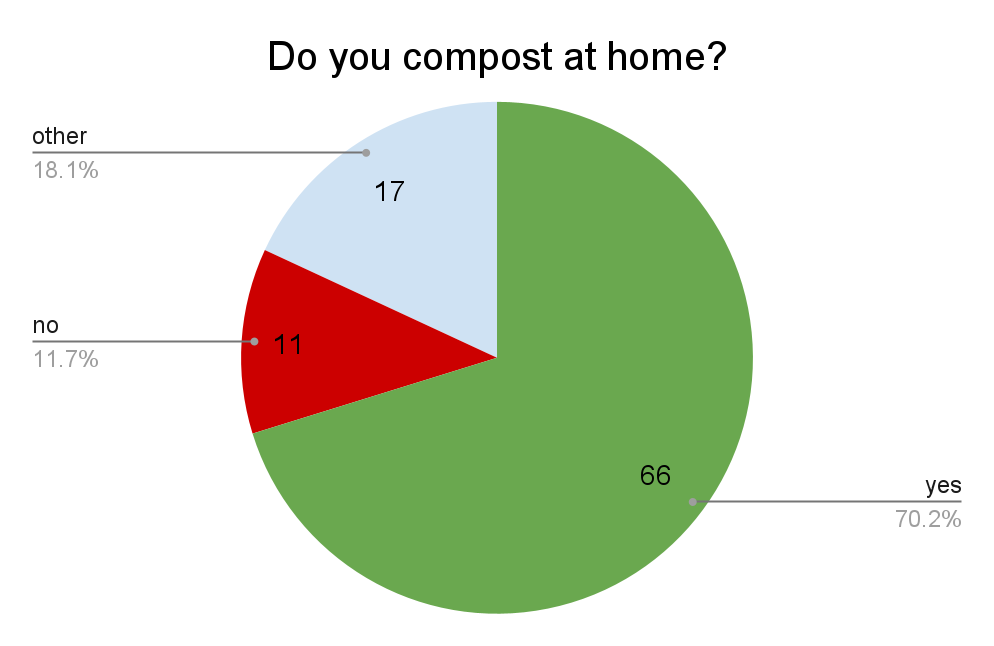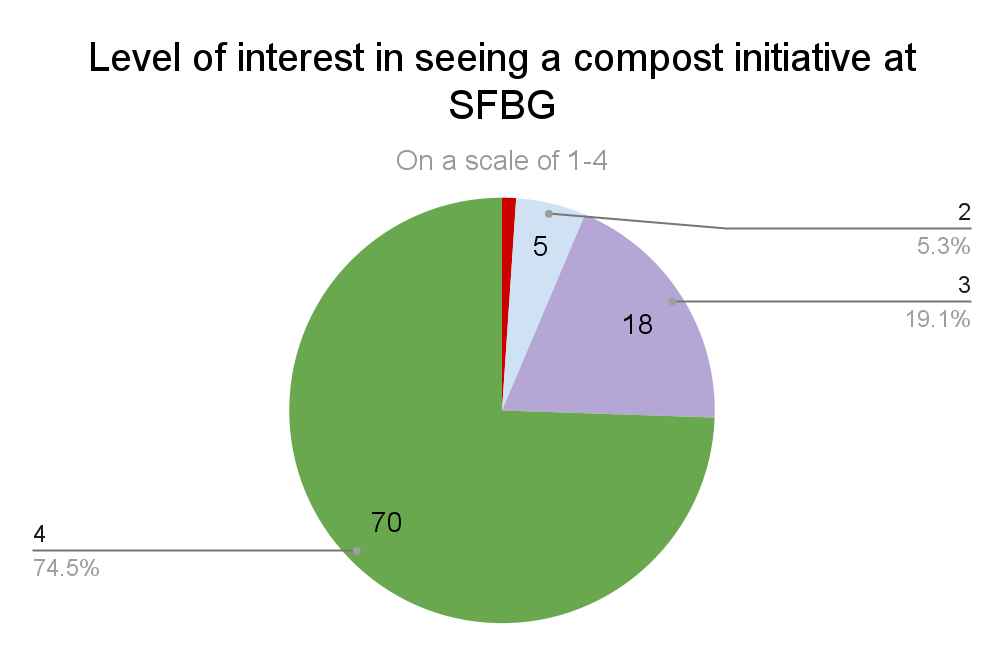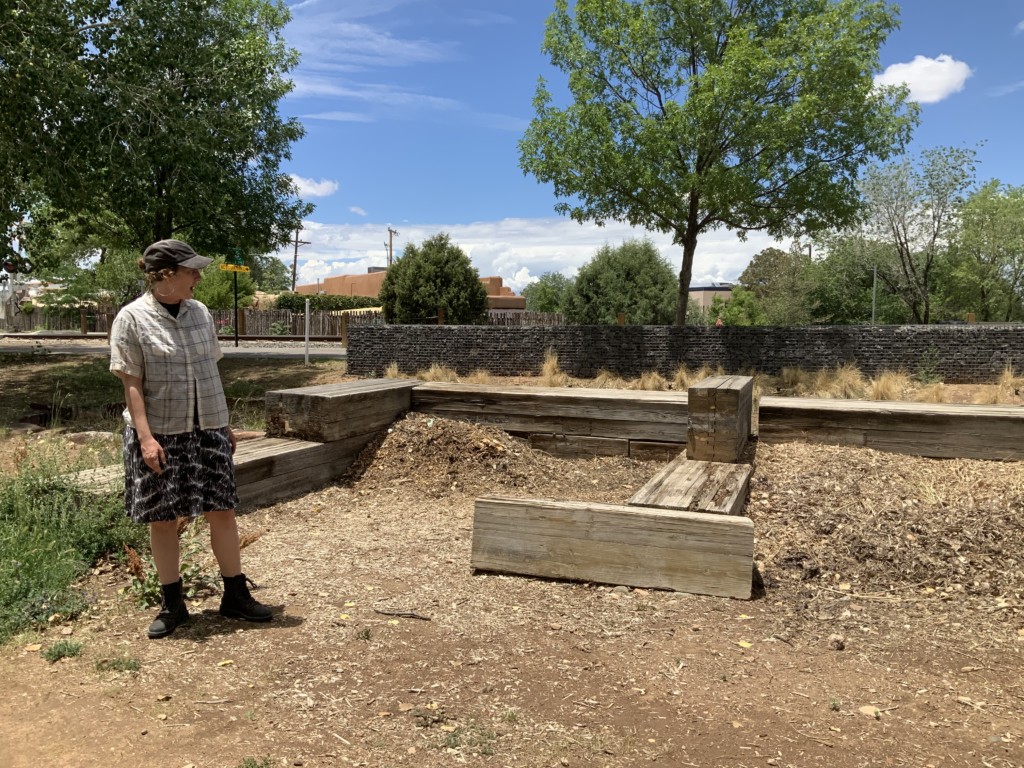July 2021
The majority of Clippings readers who responded to our online questionnaire say they already compost at home and would support some sort of composting program at the Botanical Garden, according to our findings. The questionnaire, created by our summer intern Francesca Galliano, was included in July’s Clippings enewsletter. The goal was to understand and measure community interest in implementing a composting initiative at the Botanical Garden and the general level of knowledge about composting. Fortunately, we received 94 responses! Thank you to the SFBG community for your help.
Wow! Community Composting is Popular!

The overwhelming majority of the respondents are composting. Of 94 respondents, 70% (n=66) reported that they do compost at home while 12% (n=11) reported that they do not. 18% (n=17) reported “other” where general consensus stated that people do compost through a third party or used to compost in the past but no longer do for various reasons. Selected responses include:
- “I subscribe to Reunity Resources doorstep food scraps/composting program. Once a week, Reunity picks up my food scraps bucket and leaves an empty one.”
- “I used to compost in CA but climate and wildlife have inhibited me in NM.”
The Rose, the Thorn and the Bud
We wanted to understand what motivated or prevented people in engaging with composting. Those who are composting shared answers with themes of: environmental morals and concerns, lessening waste in landfills, gardening and soil enhancement or personal daily ritual. Others who are not composting expressed challenges and themes of: rodent and smell concerns and living arrangement and equipment limitations. Selected responses include:
- “I’ve lived on the same quarter acre property in Santa Fe for about thirty-five years. Every kitchen scrap and healthy bit of vegetation has been composted. Composting is the most intelligent way to improve soil and reduce waste in the landfill. It is very simple in this climate. I make small to larger piles on the ground. No special equipment needed except a shovel. It’s wonderful to turn the compost and see the worms and watch how quickly matter breaks down and adds life to the soil and plants. It makes my soul feel whole!”
- “Why throw away all the vegetable matter and leaves from the garden when they are so needed to ameliorate the soil. Precious material! Composting and recycling go hand in hand.”
- “Give back to the earth some of what we took from her.”
- “We have too many rodents in our yard and do not wish to attract more.”
- “I live in a condo and it doesn’t allow it.”
Plant a Seed and Watch it Grow
There’s a lot of community enthusiasm! We hope that you will join us on our composting pursuit. Readers indicated on a scale of 1-4, 1 being lowest and 4 being highest, their level of interest in seeing a composting initiative be implemented at the Garden.
The highest level 4 was indicated by 75% (n=70) of respondents, while 19% (n=18) indicated a level 3, 5% (n=5) indicated a level 2 and 1% (n=1) indicated the lowest level 1.
Below is a chart that shows the values and percentages of the different levels of interest in seeing a composting initiative at SFBG indicated by respondents.

Respondents also reported which ways they’d like to see the efficiency of the composting initiative measured. Apart from waste diverted from landfills and amount of compost produced, selected responses include:
- “Focusing on how much waste is diverted from the landfill might inspire more to contribute, but I am indifferent to which route you take. Helping patrons learn how to compost effectively and deal with problems that can arise (odors, bugs, material not breaking down) might be even more beneficial than producing a lot of compost at the garden itself.”
- “Teaching about worm composting and measuring the nutrient content of the worm castings could be interesting. And, beds that are improved with the compost versus beds that are not improved as far as growth, drought tolerance, etc.”
Tell Me How You Really Feel
Respondents were also given the option to leave comments or suggestions. Selected responses include:
- “I think it’s a great idea! We need the education to eliminate the stigma of composting.”
- “Reunity Resources and Santa Fe Compost Action Team (SCAT) already have established composting programs. Collaboration with them would make better use of community resources.”
- “Composting takes time and can stink if not properly maintained. Start small….you do not want to take on a grandiose project with tons of waste.”
The community has expressed a significant interest in general composting practices as well as a composting initiative at the Garden from onsite to offsite collaborative programs.

Reunity Resources

Railyard Park Conservancy
Francesca visited five different community based compost programs based locally in Santa Fe and the greater area including: the Santa Fe Extension Master Gardners’ Santa Fe Compost Action Team (SCAT), Railyard Park Conservancy, Reunity Resources, Los Alamos Nature Center/Pajarito Environmental Education Center (PEEC) and Santa Fe Community College Controlled Environment Agriculture Program. All sites differ in size, method, patronage, success and challenge. Santa Fe Compost Action Team serves the Santa Fe community through a hay bale system. Railyard Park Conservancy also serves the Santa Fe community but through a classic floor pile system. Santa Fe Community College Controlled Environment Agriculture Program serves it’s faculty, students and staff while Reunity Resources serves the Santa Fe community through an industrial on-farm aerated static pile, vermicomposting and floor pile systems. PEEC supports the Los Alamos community by donating at-home compost kits to interested participants.
As we navigate our best options in how we can participate in the compost movement, we hope and plan to have a composting initiative implemented in the Garden soon, either onsite or in collaboration offsite.
Thank you for all of your responses and thank you to the Santa Fe Compost Action Team, Railyard Park Conservancy, Reunity Resources, Los Alamos Nature Center/Pajarito Environmental Education Center and Santa Fe Community College Controlled Environment Agriculture for having her!
Learn more about these compost efforts
Los Alamos Nature Center/Pajarito Environmental Education Center
Santa Fe Community College Controlled Environment Agriculture Program


